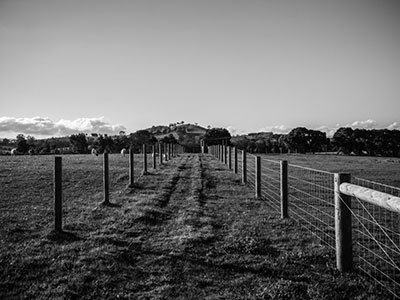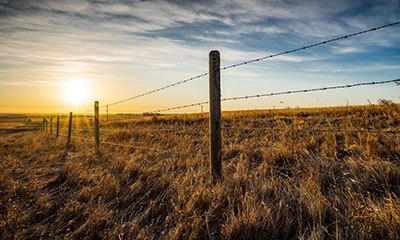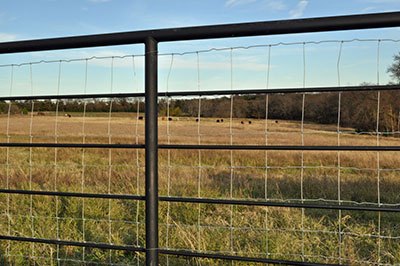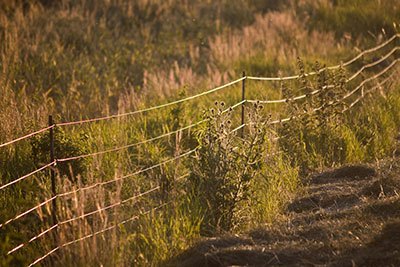As a livestock owner, you understand the importance of investing in quality agricultural fencing. You’ll ensure your animals are secure and their natural habitat is protected.
But before you begin building and installing your fence, be aware of local rules for fencing land for agricultural purposes. These regulations vary from state to state and their violation can result in costly fines or other restrictions.
In this post, we provide an overview of the general rules so that you can stay informed – and respect the law!
Take away key points:
- Eastern and Western States, and their counties have different fencing rules, so find the local laws to ensure the best systems
- Follow all fence-in and out rules to avoid further law fines ad complications
- Know the exact size of the fencing to ensure the lawful construction
Table of Contents
- The National Agricultural Law Center about the legal fence standards 2023
- What is a lawful fence?
- What is the law regarding garden fences?
- Location issues & position fences
- Adverse possession
- Practical location
- Building and maintenance requirements
- Fence in or fence out rules?
- How to handle fence disputes?
- Liability for escaped animals
- Railroad fencing systems
- Public roads through private pastures
- Highway fences & responsibility
- FAQs
- What’s the law in Indiana on fences?
- What is the fence law in Kentucky?
- How close to a property line can you put a fence?
- Can I put a fence on my property line in Indiana?
- Can I replace my fence without my neighbors’ permission?
- Who gets the good side of the fence?
- Can I build within 1 meter of the boundary?
- What size fence can you put up without planning permission?
- Can I put up a fence without planning permission?
- Summary
The National Agricultural Law Center about the legal fence standards 2023
The National Agricultural Law Center will help you find all legal fence details, considerations, and obligations to follow. You will know all standards when setting your electric fences, and learn all potential damages caused by the law violation.
Read more information here, and follow our guidelines below.
What is a lawful fence?

A lawful fence is a sufficient, substantial, good, and well-suited barrier preventing animals from escaping property and protecting the owner’s rights. The legal fence must meet certain requirements set by local ordinances or state laws by their statutory obligation.
In Texas, for example, a legal fence must be at least four feet in proper height in front yards and six feet in backyards. Additionally, it must be constructed of durable material such as wood or metal and must be kept in good repair.
In some states, such as Oklahoma, there are specific statutes that define lawful fencing. According to Oklahoma Statutes §4-154 (2020), a lawful fence must have posted at least five-inch thick lines at the top and bottom with two rails of equal thickness between them.
The rails should also be securely fastened to the posts with staples or nails no more than three inches wide. Furthermore, good fences should not exceed seven feet in height.
When building legal fences on your property, it is important to understand the laws and regulations surrounding good fences in your area. This includes researching local ordinances and making sure you have evidence of the legal property lines not to damage the other party.
Additionally, if you plan on sharing costs with your good neighbors for building a boundary fence, make sure you both agree to the fence agreement terms beforehand. The other landowners must be aware of their duty to fence maintenance and upkeep of the fence.
What is the law regarding garden fences?
Garden fences are a great way to add privacy and security to your outdoor space. However, it is important to be aware of the common law duty regarding garden fences before you begin any construction project.
Depending on where you live, there may be regulations in place that dictate the height, material, and design of your fence. Additionally, some cities or counties may require you to obtain a permit or a written fence agreement with adjoining property owners before building a fence.
It is best to research local laws and regulations before beginning any fencing project. This will ensure that your fence meets all requirements and that you are not subject to fines or other penalties for non-compliance with neighboring landowners.
Additionally, if you plan on installing a fence near a property line, it’s important to check with your adjacent landowner or good neighbors first as they may have an opinion on the type of fence being installed.
Overall, garden fences can be an excellent addition to any outdoor space. By researching local laws and regulations beforehand, you can ensure that your fence meets all requirements while also providing the desired level of privacy and security for your home or business.
Location issues & position fences

Typically, state law mandates a partition fence to be put on the line that separates tracts of land owned by different individuals. However, the law also allows for the fence to be entirely on one side of the boundary, as seen in statutes such as Kan. Stat. Ann. §§29-316 and 317, and 2 Kan. Stat. Ann. §60-503.
When a partition fence is situated on one side of the property boundary, it may not raise any concerns regarding land ownership. But if one partition fence has been in place long enough for adjacent landowners or other landowners to consider it as the boundary, the fence may become the official boundary.
Therefore, in an agricultural setting, property usage is more likely to determine property boundaries and property disputes. Two different yet related theories may apply to determine how much land is owned by the adjacent owner & legal issues.
Adverse possession
Adverse possession is a legal doctrine that allows one landowner to claim ownership of land owned by another. The other landowner can refer to the senior staff attorney due to occupying the land for an extended period, usually two to 21 years depending on the state.
The subsequent owners must know that they are occupying someone else’s land and must make open and notorious use of it to make the fence law successful. The original owner must also not take any action to remedy the situation within the statutory timeframe.
Adverse possession has been used throughout history as a means of acquiring property rights, making it one of the most contentious methods of doing so.
Practical location
The Doctrine of Practical Location is a legal principle that can be used to resolve fence disputes over land boundaries. The written notice is based on the idea that if two parties have been using a fence or other structure as a boundary for an extended period, it can become the actual boundary line between their properties.
Additionally, this fence law may also apply when one party has a good faith belief that they own the property up to a certain point, even though they are not sure where the exact boundary lies. The doctrine will also prevent livestock escape from their designated areas, and allow them to move around certain remote parts.
In New York and other states, this doctrine has been used to establish permanent boundaries between adjacent properties. This allows for greater certainty when it comes to ownership and can help prevent future disputes over land boundaries.
Overall, the Doctrine of Practical Location is an important legal principle in many states providing clarity and stability when it comes to fence and land boundaries. By recognizing fences and other structures as potential boundaries, this doctrine will require livestock owners aware of their rights and obligations regarding their property.
Building and maintenance requirements
Partition fences are a common feature of many neighborhoods, and it is important to understand the legal obligations associated with them. In general, they are required to build and maintain in good repair all partition fences in equal shares, unless the livestock parties agree otherwise.
This duty to fence confers on the landowner the privilege to lawfully enter onto the property of the adjoining livestock owner at reasonable times and in a reasonable manner to maintain the fence.
Various adjoining landowners refer to the “right-hand” or “left-hand” rule. The rule explains they face each other at the mid-point of their fence. The partition fence rule will also require livestock owners to build and/or maintain the portion of the fence to either their respective sides – right or left.
In addition, the neighbors can also require a written legal fence agreement specifying which part of the fence they are responsible for building and maintaining. Such an official document will solve the potential disputes between the neighbors, and each party will know their obligations.
However, you must also check your local law representatives for multiple extra requirements and regulations referring to the partition fences. The laws may vary from state to state, so you must know all details in advance.
Fence in or fence out rules?

In states located outside of the western part of the United States, the ‘fence-in‘ rule applies. The fence-in rule requires livestock owners to fence their animals in, rather than requiring adjoining landowners to build and maintain partition fences. So, the fence-in rule also ensures there is a sufficient fence standard if the livestock trespass into the forbidden territory.
However, in these states, owners of adjoining lands are still required by law to build and maintain partition fences in equal shares. The partition fence might occasionally cause issues between livestock owners and non-livestock owners sharing the same fence.
If an adjacent non-livestock owner does not participate in maintaining their part of the fence respectively, and the party is injured due to a defective fence, the party cannot recover damages caused by the adjacent landowner’s trespassing livestock.
Conversely, a non-livestock owner might be liable for others harmed by the neighbor’s livestock escaping through the damaged fence parts they are mandatory to maintain. However, many states may have unique rules that apply to certain situations, such as found in Kansas Statutes Annotated §29-309.
How to handle fence disputes?
Adjoining landowners may be able to reach an agreement about the responsibility for building and/or maintaining a partition fence. When they reach an agreement, it is wise to put the terms in writing and record them in the county Register of Deeds office for the area where the fence is located.
If no agreement can be made between neighboring landowners, most states have regulations that require that fence viewers should be called. The fence viewers are typically a governmental body of elected officials who have been assigned this task by law.
For example, under Kansas law, the county commissioners (or their designees) in the county where the fence is located are responsible for viewing fences, and the fence viewers will make further decisions for further duty laws.
Moreover, most states provide detailed rules regarding how to fence viewers should conduct their inspection. For example, laws apply if:
– a majority vote is required or
– an appeal procedure exists or
– one of the landowners objects to the conclusions of the fence viewers.
Finally, state laws use a specific system to get any repairs made and ensure that proper compensation is provided for any work done on a partition fence.
Liability for escaped animals
In fence-in jurisdictions, livestock owners are generally liable for damages if their animals escape through a faulty fence. But if the fence is in good condition, there isn’t usually any liability unless they can be proven negligent. This negligence could include:
– leaving gates open,
– not constructing or maintaining the fence properly,
– knowing that the cattle were in heat and needed more secure enclosures or closer watch,
– or knowing that the livestock had escaped and failed to return them to the enclosure.
The regulations also apply when livestock wander onto a public road and injure motorists. Liability rests on proving that the owner was negligent. Some jurisdictions employ the doctrine of Res Ipsa Loquitor which could shift this burden of proof onto the livestock owner and require them to prove that they weren’t at fault for failing to keep their graze livestock enclosed.
Regarding the distraint laws, if livestock from a neighboring property trespass onto the land of an adjoining property owner who has lawfully fenced their land, the adjoining owner may have the right to keep the livestock in distraint.
State law usually allows for this, allowing for the retaining livestock until damages and the cost of distraint are paid. The livestock owner must be notified shortly after the animals are taken into custody. If the livestock can’t be found, notification is given to the sheriff. After that, they can only be held for a few days without taking legal action against them.
Another option that various states provide is that the sheriff can be called upon to fetch the trespassing livestock and dispose of them as the states require owners.
Railroad fencing systems
Landowners typically do not have any responsibility for building or maintaining railroad fences. However, the liability of railroads for damages caused to livestock hit by trains is generally not dependent on negligence. This liability can be waived by contract with adjacent landowners, but railroads can also avoid it altogether by enclosing their tracks with a lawful fence.
Adjoining owners may require a lawful or hog-tight fence, but they cannot demand an electric one. If the railroad fails to build a fence along its right-of-way, state laws usually provide landowners with procedures to get one constructed. Issues can arise if a railroad decides to abandon its lines, which may leave the adjoining landowner without protection from trespassing animals.
Public roads through private pastures
In certain states between the Great Plains and further west, there might be publicly-owned roads that cross through privately-owned pastures with permission from public officials.
This can take the form of a gate or fence in these areas, but it cannot be locked to deny general public access. The road may be guarded by either an automated gate or a cattle guard – if there is a gate present and left open, criminal penalties may be imposed.
Highway fences & responsibility
In some states, landowners may be expected to build highway fences. However, other states require the state highway commission or Department of Transportation to take responsibility for keeping highways in a reasonably safe condition under common law.
FAQs
What’s the law in Indiana on fences?
Fences cannot be taller than six feet, built or maintained to purposefully annoys adjoining landowners.
What is the fence law in Kentucky?

Lawful fence refers to:
– A strong and sound fence four feet high, so close that livestock cannot creep.
– Made of rails, plank, or barbed wire fence, and iron, plank, hedge, brick, or stone
– A ditch is three feet deep and three feet apart with a hedge of two feet.
How close to a property line can you put a fence?
You can place the fence two to inches apart from the property line.
Can I put a fence on my property line in Indiana?
Yes, you can build the right half of the livestock fence in your boundaries, so as not to annoy the adjoining landowner.
Can I replace my fence without my neighbors’ permission?
You can build or replace the livestock fence in most counties without your neighbors’ permission.
Who gets the good side of the fence?
Your neighbor gets the good side of the fence.
Can I build within 1 meter of the boundary?
You must build one meter away from the boundary.
What size fence can you put up without planning permission?
It should not exceed one meter in height next to a highway, and two meters in height if elsewhere.
Can I put up a fence without planning permission?
No, you need planning permission to build a livestock or similar fence.
Summary
As you can see, there are various fence-in and fence-out rules, regarding livestock, gardens, and your properties. Get permission first and do not annoy your neighbors for the best fencing systems.

